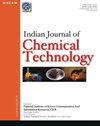Investigation of Laurus Tamala leaves extract as an environmentally acceptable corrosion inhibitor for soft steel in 1M HCl: Electrochemical, DFT, and surface characterization techniques
IF 0.5
4区 工程技术
Q4 CHEMISTRY, APPLIED
引用次数: 2
Abstract
Laurus Tamala leaves extract (LTLE) has been employed as a soft steel corrosion inhibitor in a 1M Hydrochloric acid media. Chemical (weight loss) and electrochemical investigations were carried out to assess the corrosion rate and percentage inhibition efficiency of the extract. The electrochemical polarization results have demonstrated that plant leaves extract functions as a mixed type inhibitor. The stability of the inhibitor is tested at elevated temperatures by weight loss method. The corrosion inhibition mechanism is interpreted through adsorption mechanism, and the LTLE components has obeyed the Langmuir adsorption isotherm for soft steel. The interaction of the components of the extract is assessed through FT-IR technique. The surface morphology, roughness and hydrophobicity in presence and absence of the extract have been characterized through SEM, AFM and water contact angle techniques respectively. The highest inhibitory efficiency is 96.21% for 24 h as recorded by weight loss method. Additionally, the DFT computations has revealed the inhibitor’s adsorption through electron donor-acceptor interactions.塔玛拉月牙叶提取物在1M盐酸中作为环境可接受的软钢缓蚀剂的研究:电化学、DFT和表面表征技术
月桂塔玛拉叶提取物(LTLE)在1M盐酸介质中作为软钢缓蚀剂。进行了化学(失重)和电化学研究,以评估提取物的腐蚀速率和百分比缓蚀效率。电化学极化结果表明,植物叶片提取物具有混合型抑制剂的作用。用失重法测试了该抑制剂在高温下的稳定性。通过吸附机理解释了LTLE的缓蚀机理,LTLE组分对软钢的吸附服从Langmuir等温线。通过FT-IR技术评估提取物组分的相互作用。通过扫描电镜(SEM)、原子力显微镜(AFM)和水接触角技术分别表征了存在和不存在提取物时的表面形貌、粗糙度和疏水性。减重法测定24 h最高抑菌率为96.21%。此外,DFT计算揭示了抑制剂通过电子供体-受体相互作用的吸附。
本文章由计算机程序翻译,如有差异,请以英文原文为准。
求助全文
约1分钟内获得全文
求助全文
来源期刊

Indian Journal of Chemical Technology
工程技术-工程:化工
CiteScore
0.90
自引率
20.00%
发文量
17
审稿时长
6-12 weeks
期刊介绍:
Indian Journal of Chemical Technology has established itself as the leading journal in the exciting field of chemical engineering and technology. It is intended for rapid communication of knowledge and experience to engineers and scientists working in the area of research development or practical application of chemical technology. This bimonthly journal includes novel and original research findings as well as reviews in the areas related to – Chemical Engineering, Catalysis, Leather Processing, Polymerization, Membrane Separation, Pharmaceuticals and Drugs, Agrochemicals, Reaction Engineering, Biochemical Engineering, Petroleum Technology, Corrosion & Metallurgy and Applied Chemistry.
 求助内容:
求助内容: 应助结果提醒方式:
应助结果提醒方式:


